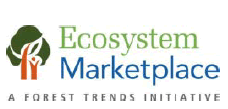Media Contact
Molly Peters-Stanley
Phone: 202-298-3005
Email: [email protected]

2 November 2012 | Washington, D.C. | The price of forest carbon credits doubled in 2011, leading to a record market value of $237 million according to Leveraging the Landscape: State of the Forest Carbon Markets 2012.
The report, which aggregates data from 451 individual forest carbon projects historically, was published Thursday by Forest Trends’ Ecosystem Marketplace, a world-leading provider of news, data and analytics on environmental markets and investments in conservation. The report examines a variety of strategies for injecting financial resources into projects that save or plant forests that capture carbon. Carbon offsets from these projects averaged $9.2 per tonne of sequestered carbon in 2011, up from $4.6 per tonne in 2010.
Private-sector institutions seeking to offset emissions continue to be the dominant source of demand.
“Many companies choose forest-carbon offsets because the projects are tangible and often support benefits beyond carbon sequestration, such as biodiversity,” says Katherine Hamilton, Ecosystem Marketplace Managing Director. “At the same time, we’re seeing some of the innovation developed in this voluntary marketplace feed into compliance programs.”
That is reflected in the sharp increase in the number of governments in locations like California, Australia, and Canada that included forests in national or regional emissions-reduction programs, but the report also documents a surge in transactions of credits developed under the United Nation’s Clean Development Mechanism – reflecting the growing diversity of the marketplace.
“Last year, market value was buoyed by a diverse landscape of actors, funding sources and projects – mostly in sectors where an emerging price on carbon is writ large,” says Molly Peters-Stanley, Ecosystem Marketplace Carbon Program Manager. “Our findings demonstrate that continued growth requires both price signals and a wide array of actors innovating and financing forest carbon solutions.”
The report found 18 million hectares impacted by carbon finance in 40 countries. The majority of projects were on private land but increasingly involved communities and smallholder landholders.
“To address the drivers of deforestation, we need to establish innovative ways of enabling forest conservation,” says Michael Jenkins, Forest Trends President. “As this type of investment gains increasing attention, transparency and access to information are critical for empowering the range of stakeholders and facilitating effective investments in reducing greenhouse gases.”
For detailed figures and analysis, we urge you to view the report in its entirety. It can be downloaded at: http://www.ecosystemmarketplace.com/reports/forestcarbon2012
This research was financially enabled by Premium Sponsors: the World Bank BioCarbon Fund and the Code REDD Campaign; Sponsors: Baker & McKenzie, Face the Future, the Kinship Conservation Fellows program and the UK Forestry Commission’ Woodland Carbon Code program; as well as donations from Astrium Services and Conservation International.

